By the most modest accounts, Iceland is home to over 10,000 waterfalls. We have compiled a list of the 13 most viewable waterfalls in Iceland. Some are viewable right off the main road while others require a modest, and occasionally arduous, hike to reach. Among the list are the “Waterfall of the Gods”, the “Golden Waterfall”, the “Most Powerful Waterfall in Europe” and the coolest waterfall you can walk behind in the world. Each of these most viewable waterfalls in Iceland are unique and distinctive in their own right . . . you be the judge.
The word “foss” in Icelandic means waterfall, so including the word “waterfalls” with the name is actually redundant. Because Icelandic is such an old language we’ve included a phonetic spelling to help for pronunciation purposes though there are certain Icelandic sounds for which no equivalent English sound exists. We begin our waterfall journey much as you might when entering the country, in the southwest corner, at the Keflavik International Airport and working your way around Iceland’s infamous Ring Road going west to east and south to north.
Gullfoss
Pronounced: good • de • foss
We’ll start our list of most viewable waterfalls in Iceland with the country’s most recognizable, and popular, waterfall . . . Gulfoss. The so-called “golden” waterfall gets its name from the unique color revealed when sunlight hits the water directly. Gullfoss is technically two different falls, each of which flows from the Hvítá (free • ta) River and is easily accessible via paths and stairs. The upper section takes on an oval shape that drops 36’ (11m) and is viewable from two different platforms, one high above from a distance and another large lava rock area that sits on the upper section. The latter viewing area also provides the best views of the more famous lower section.
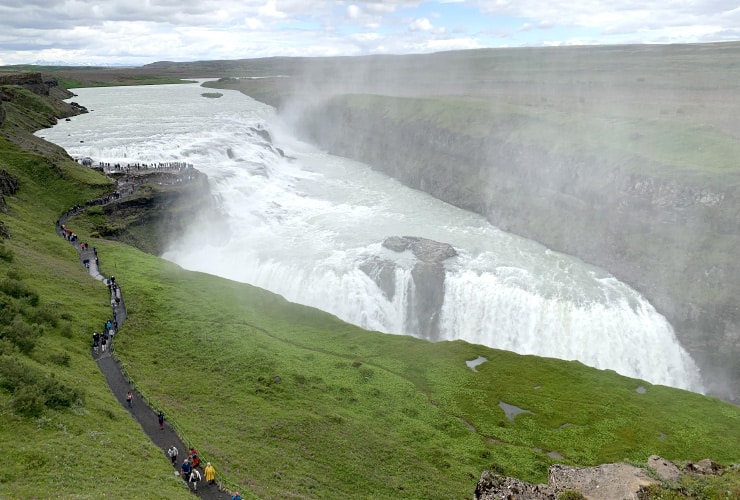
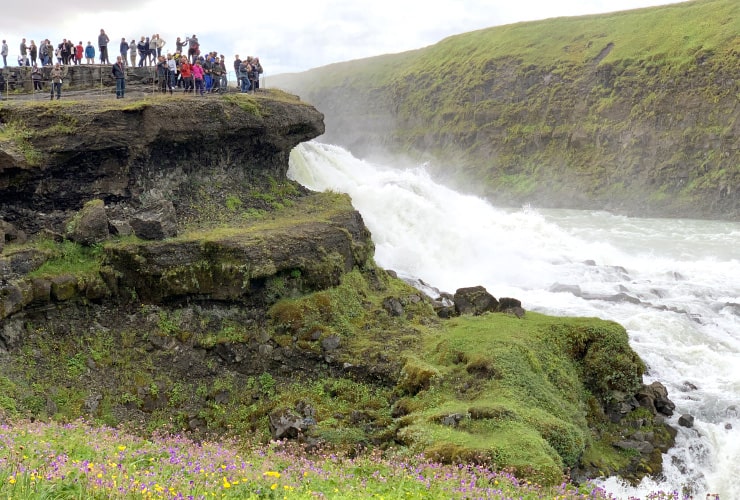
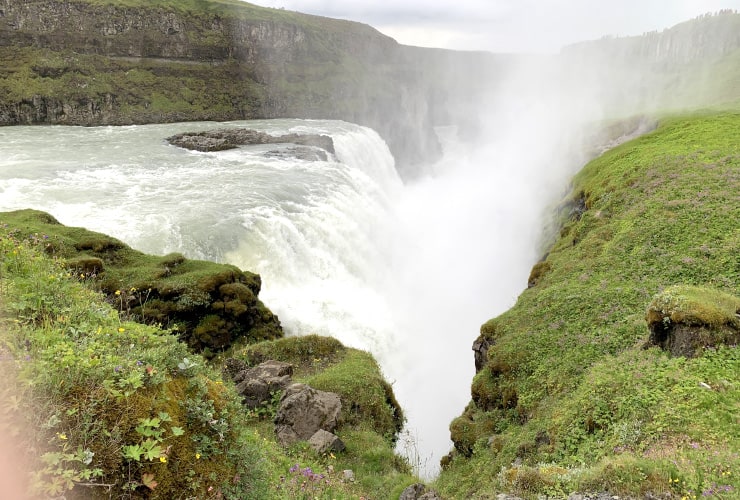
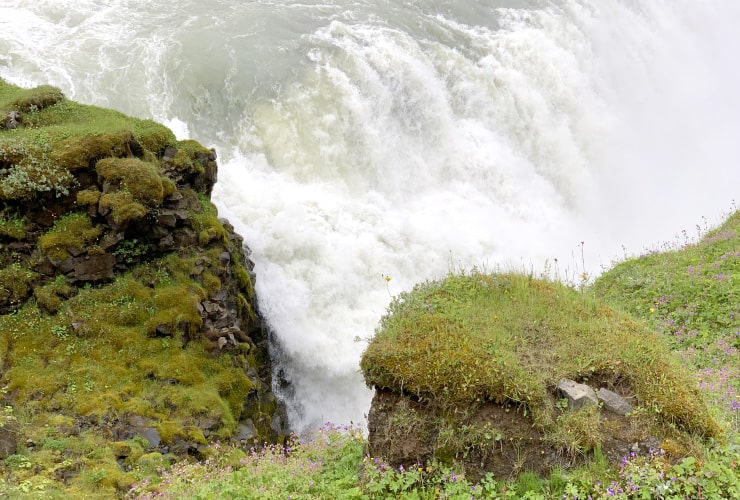

The lower section of Gullfoss has a drop of 69’ (21m) with an average water flow of 3,849 cu’ (109 cumec). This massive generation of power almost resulted in Gulfoss being converted into a hydroelectric plant in the early 20th Century. Only the efforts of one Sigríður Tómasdóttir, who threatened to jump over the falls, preserved this natural wonder from being destroyed. During the summer this amazing “cataract” falls represents the largest volume falls in all of Europe. The sound alone is enough to get your attention and humble the most cynical of visitors. This most viewable waterfall in Iceland has been a protected natural reserve since 1979.
Seljalandsfoss
Pronounced: sell • lee • ah • lans • foss
Seljalandsfoss is a personal favorite and the most immersive experience among the most viewable waterfalls in Iceland. Like Grotto Falls (Smoky Mountains), you can engage Seljalandsfoss from every conceivable angle and perspective just on a much larger scale. Measuring an impressive 200’ (62 m) in height, the “selling the land of waterfalls” has multiple drop-off points that converge at groundfall at two primary points. The falls are fed by the Seljalandsá river which gets much of its runoff from the glacier Eyjafjallajökull, site of the 2010 volcanic eruption that caused all European air traffic to shut down for a week.
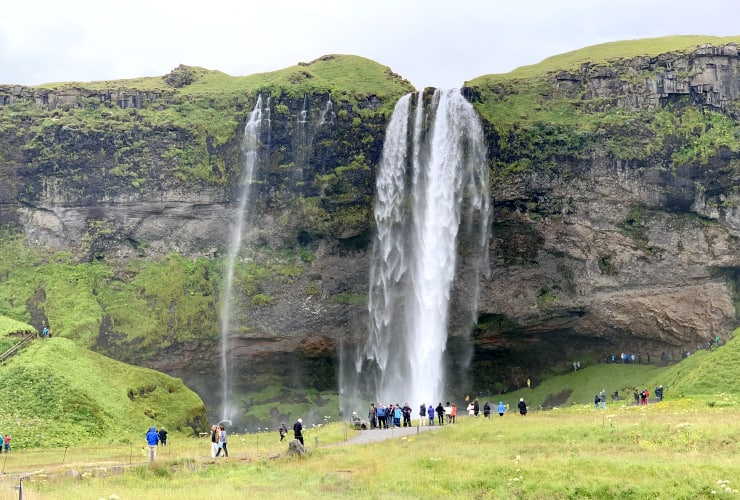

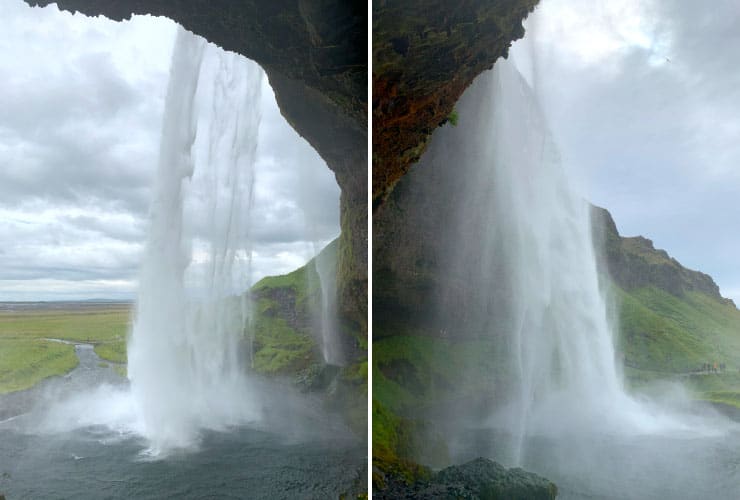
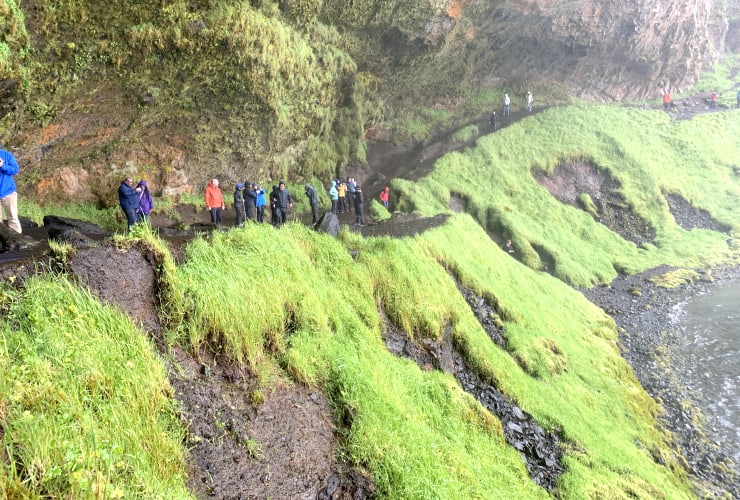
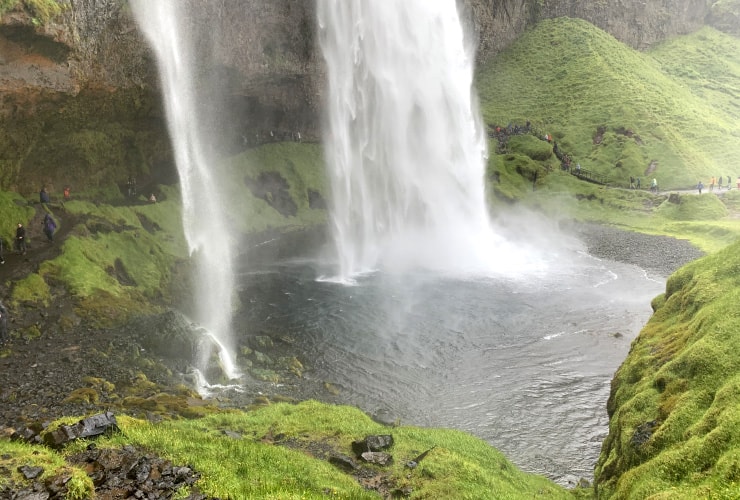
Like so many of the most viewable waterfalls in Iceland, Seljalandsfoss can first be seen from the Ring Road. In fact, you can also see two other falls just to the north on the same mountain plain. As you approach you’ll see wooden stairs that turn into a rock path, taking you around behind the falls. The path winds around upward until you see the falls from the complete opposite side. Every step of this journey is slippery, dramatic, awe-inspiring, beautiful and filled with bright green moss. You definitely want to wear waterproof gear including boots . . . you will get quite wet. Seljalandsfoss is extremely popular, and can get quite crowded, yet somehow you barely notice others as these amazing falls completely capture your full attention.
Skógafoss
Pronounced: sko • rah • foss
As you pass the eastern edge of the mighty Eyjafjöll mountains you catch a glimpse of Skógafoss. Considered the second most viewable waterfall in Iceland, this 200’ (62 m) tall and 82’ (25 m) wide falls is breathtaking. You can walk right up as close as you like to the base but you’ll probably get wet no matter your vantage point as the spray is quite prodigious. If you’re truly ambitious there is a 400+ step wooden staircase that leads to the top. You’ll see multiple birds that call the mountainside their home.
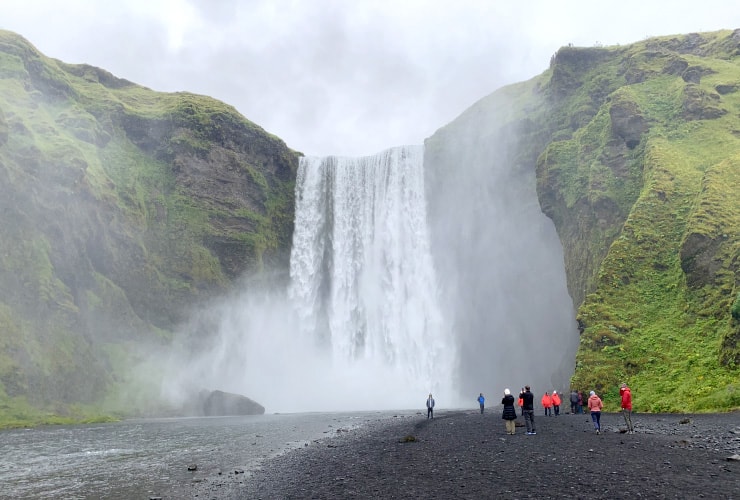
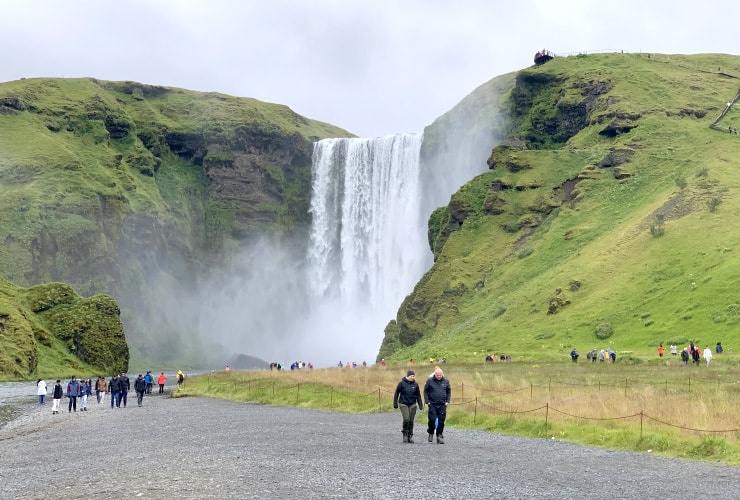
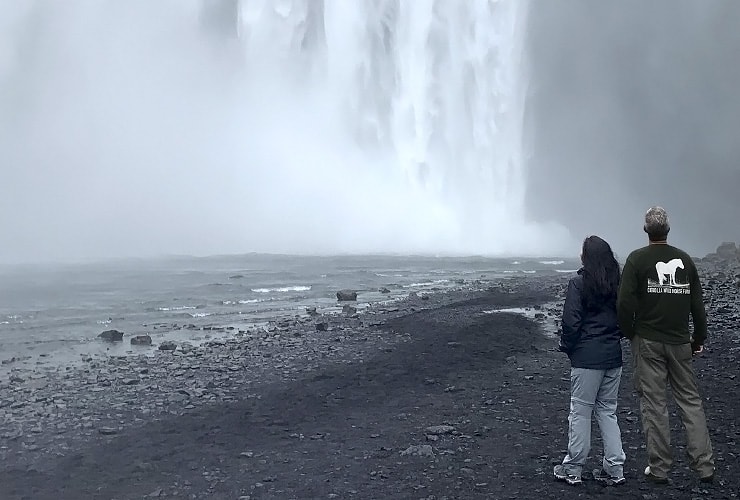

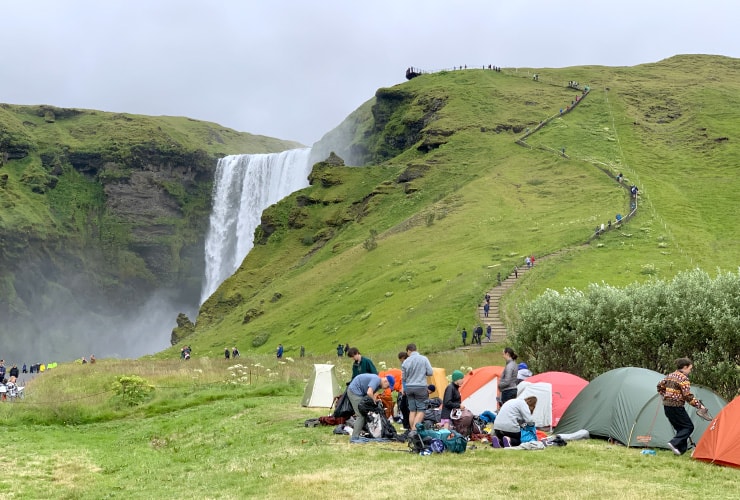
On sunny days it is not uncommon to see two distinct rainbows form along the bottom of Skógafoss. Legend has it that Þrasi Þórólfsson, the first Viking to have discovered Iceland, buried treasure behind the waterfall but only the ring on the side of Þrasi’s chest of gold was ever found and is on display in Skógar Museum. These falls also represent the former coastline of Iceland and are fed by two different glaciers, Eyjafjallajokull and Mýrdalsjökull. If you’re on your own consider walking the most popular hiking trail in Iceland, Fimmvorduhals, which begins (and ends) atop Skógafoss. The hike is only open in the summer and is best done in 2 days. There are shelters along the way and it covers 15.5 miles (25 km) with tons of waterfalls and other scenic delights.
Foss a Síðu
Pronounced: foss • a • syd • de
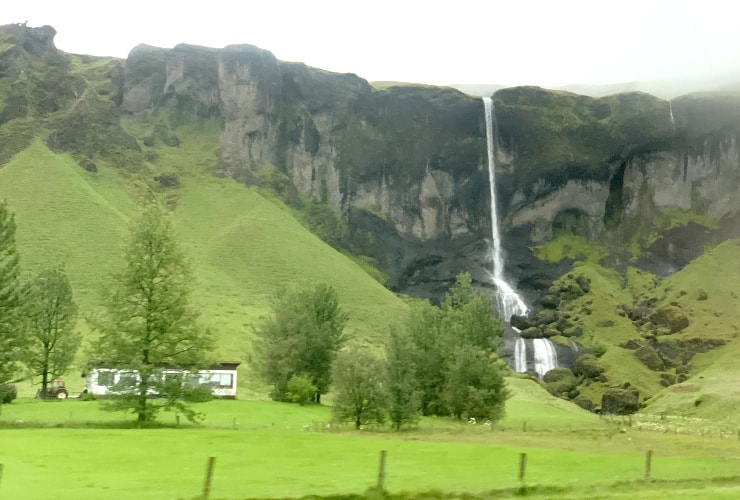
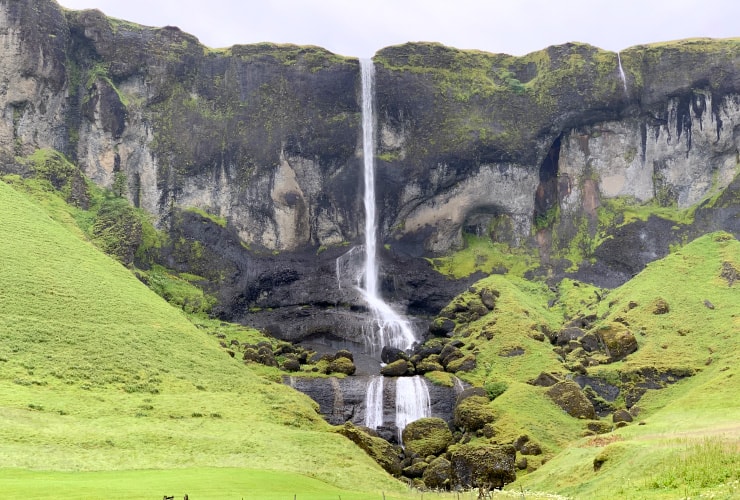
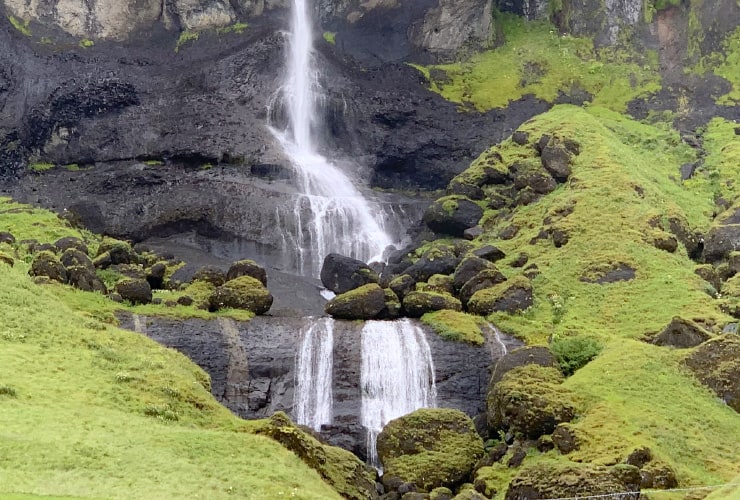
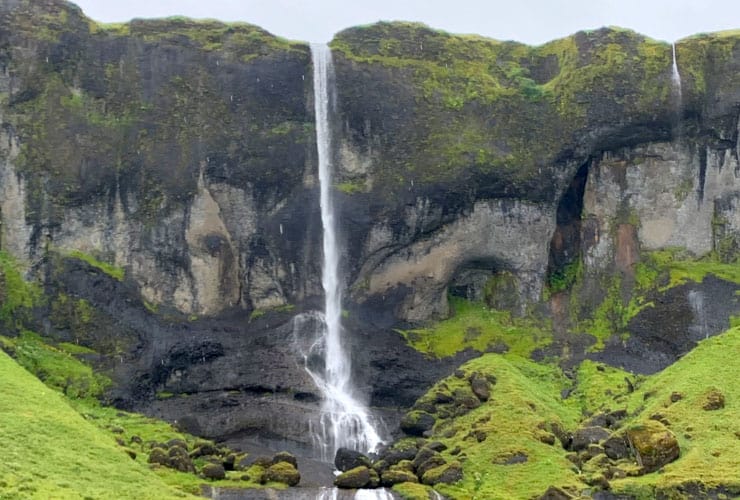
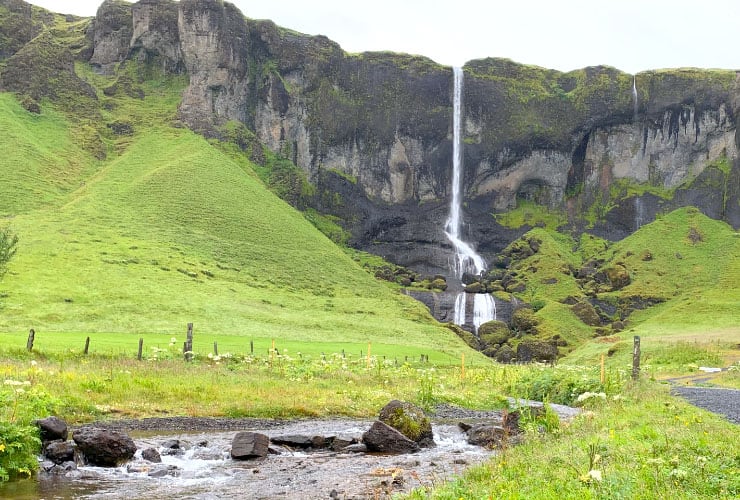
Fossá Síðu is a beautiful small farm located just off the Ring Road just under 9 miles (14 km) east of Kirkjubæjarklaustur. The farm dates back to Iceland’s “Settlement Era”, late 900 AD, and is even associated with a curse lasting more than nine generations. When you see the farm and in particular, Foss a Síðu, dealing with a curse seems a small price to pay to live in such beautiful surroundings. The falls can be seen from the road and even has a special turnoff so you can get a better view. While Foss a Síðu is “just” 98’ (30 m) in height it has 3 distinct levels, each with its own personality, and is known as the “sideways falls” due to wind shear curving the top stream of water as it descends. The intricacy of the falls and the magnificence of the surrounding cliffs make it one of the most viewable waterfalls in Iceland.
Fossárdalur
Pronounced: foss • sow • va • loosh
Fossárdalur is located about a mile (1.8 km) off the Ring Road, via a windy gravel road, on the west side of the Berufjõrður fjord. It is the final waterfall in a series along the Fossá River so-called Fossárdalur, or Waterfall Valley, before it empties into the Atlantic Ocean. Also known as Sveinstekksfoss, this 50’ (15 m) waterfall is secluded lending an intimacy to the otherwise tranquil surroundings. From a well-positioned platform one gets an excellent view of all (4) levels of Fossárdalur. The first two levels are active and violent leading to a calm section, which empties into a final pool before finally heading further downstream. The bottom section is notable for the bright blue coloring it produces.
Litlanesfoss
Pronounced: yeet • plan • ness • foss
Get ready for a bit of a trek . . . 3.1 miles (5 km) up-and-back round trip that is all uphill going then downhill on the way back. The payoff? Two of the more distinctive and most viewable waterfalls in Iceland. The first part of the trail features a beautiful gorge with a number of smaller falls and rocky cascades. About ¾ mile (1.2 km) in you’ll arrive at Litlanesfoss with its unique vertical bronze basalt columns framing the 2-level 98’ (30 m) high falls. The top of the falls are partially hidden but the up to 65’ (20 m) high basalt columns, serving almost like rock curtains, are the real star of Litlanesfoss. Stay for a bit, get your breath back, then peek just at the top of the distant mountain beyond and you’ll get a glimpse of your next destination . . . Hengifoss.
Hengifoss
Pronounced: hang • gee • foss
Hengifoss is the 3rd tallest waterfall in all of Iceland. From top-to-bottom it measures an impressive 420’ (128 m). By contrast, Niagara Falls measures a relatively paltry 325’ (100 m). As you cross beyond the fresh water stream (be sure to refill your water bottle) you’ll see a number of smaller waterfalls to the west. Despite its enormous size what makes Hengifoss so distinctive are the alternating black basalt and red clay bands that surround the falls. As you approach the path it changes from dirt to wood lattice until you reach a platform complete with a bench to relax. You can go further to get a better view but you have to venture quite a bit further to see significantly more than the platform view. The trip back down is all downhill and provides a wonderful view of the valley Fljótsdalur (Valley of the River), the forest of Hallormstaður and the lake of Lagarfljót.
Rjúkandafoss
Pronounced: hugh • kan • da • foss
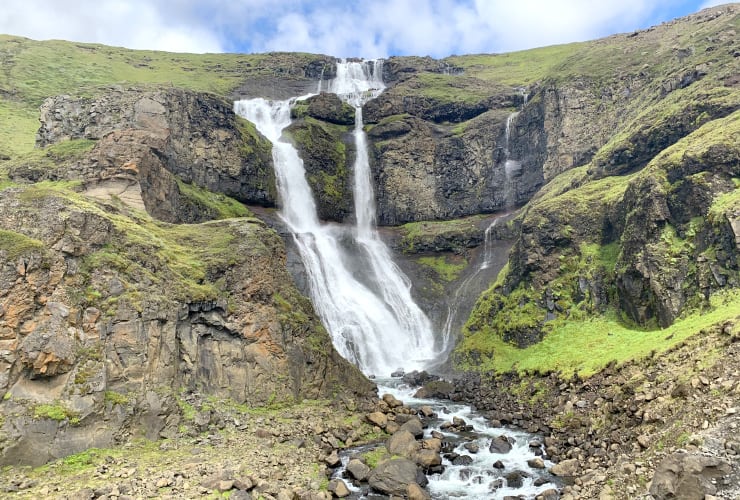
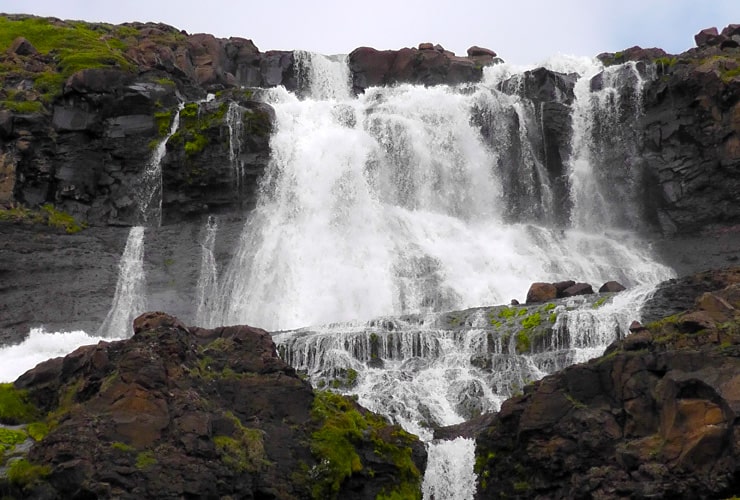
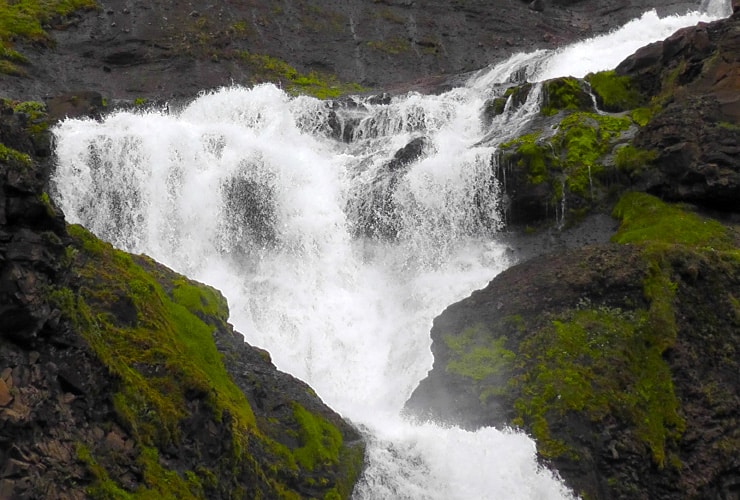
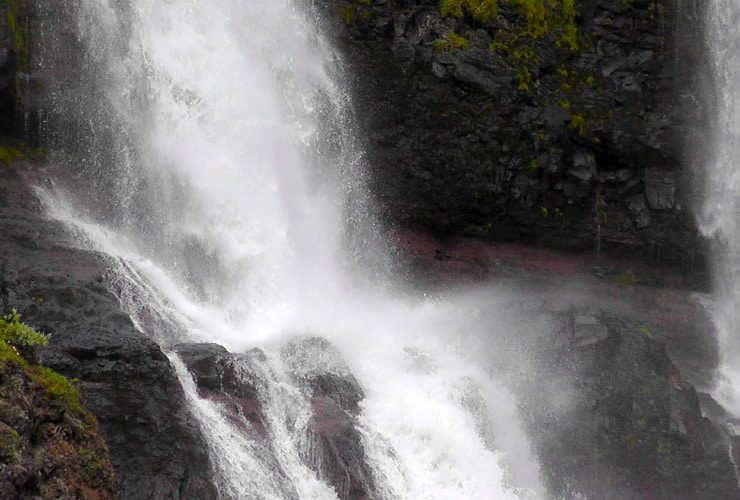
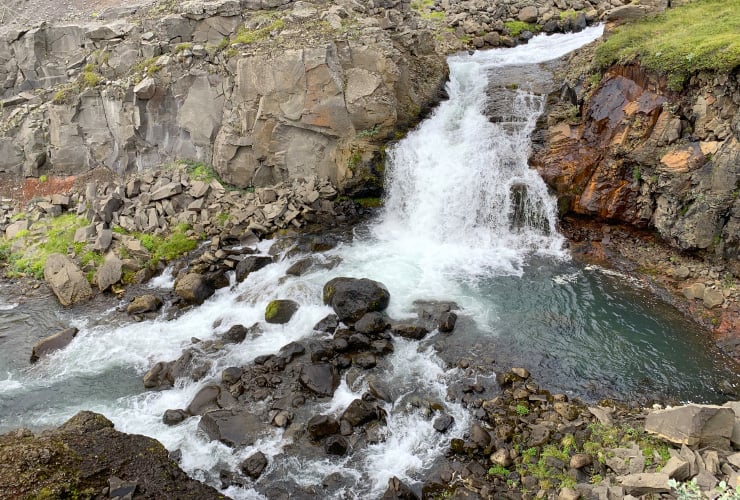
Rjúkandafoss, or Rjúkandi Waterfall, is one of the most viewable waterfalls in Iceland due to its easy access from the Ring Road and the short walk needed to get a closer look. The falls are in two major sections but they appear more interesting because of how the water cascades over the bedrock. The top section has a veiling horsetail style drop of 109’ (33 m) that produces a second drop of 196’ (60 m) that falls over two different channels. Further downstream is another small falls that are interesting though technically not part of Rjúkandafoss. These falls are beautiful, not overrun by visitors and quite accessible. Seen clearly from the road it is worth a 30-minute visit.
Dettifoss
Pronounced: debt • tea • foss
The best word to describe Dettifoss is powerful. Indeed it is considered the most powerful waterfall in all of Europe with an impressive water flow of 6,186 cu’ (193 cumec). Add to that a downward plunge of 150’ (45 m) spread across a 300’ (100 m) wide span and you have a breathtaking natural phenomenon. Dettifoss is fed by the Jökulsá á Fjöllum river whose source is none other than Vatnajökull, the largest glacier in Europe. There is nothing about this most viewable waterfall in Iceland that is subtle or delicate. It is pure power unleashed for all to see and well deserving of its nickname, “The Beast”.
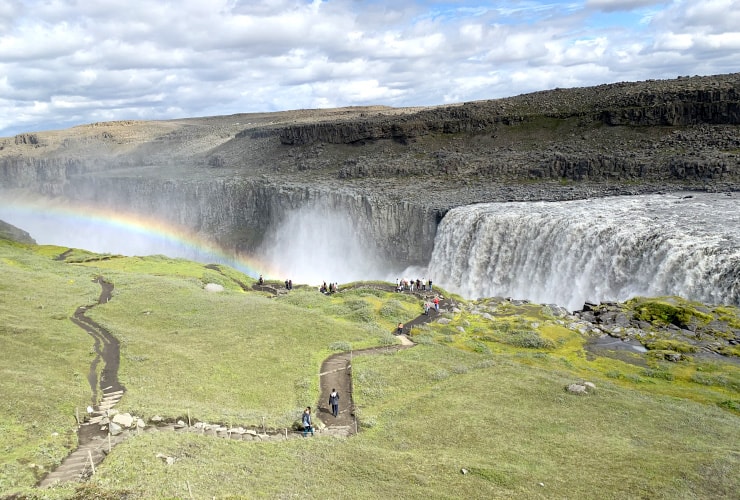
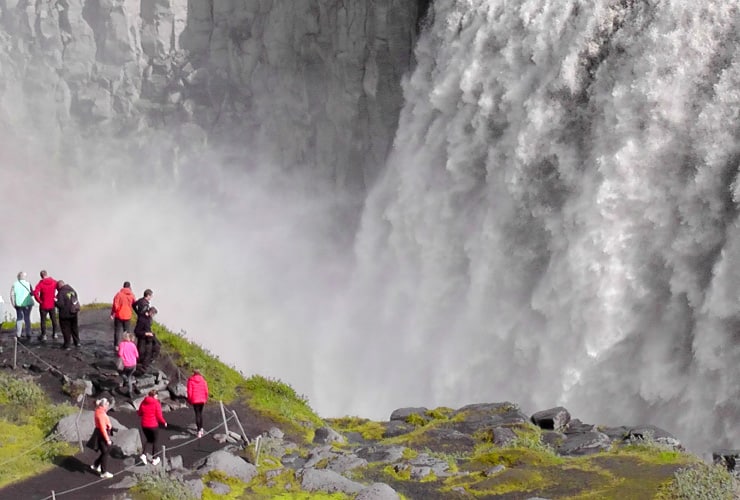
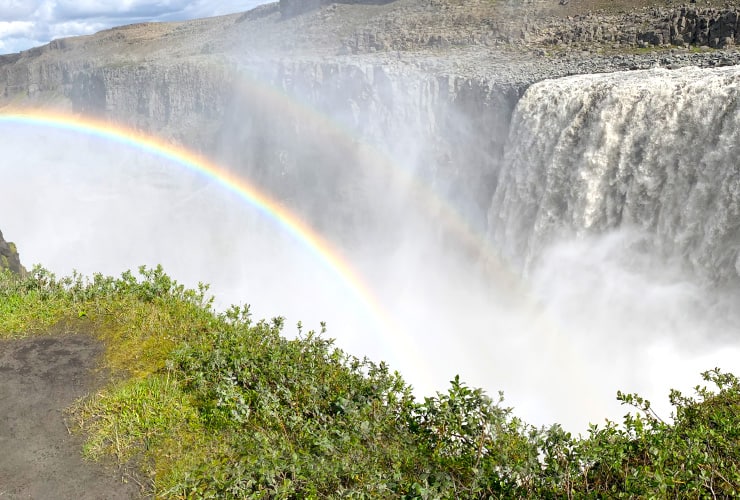
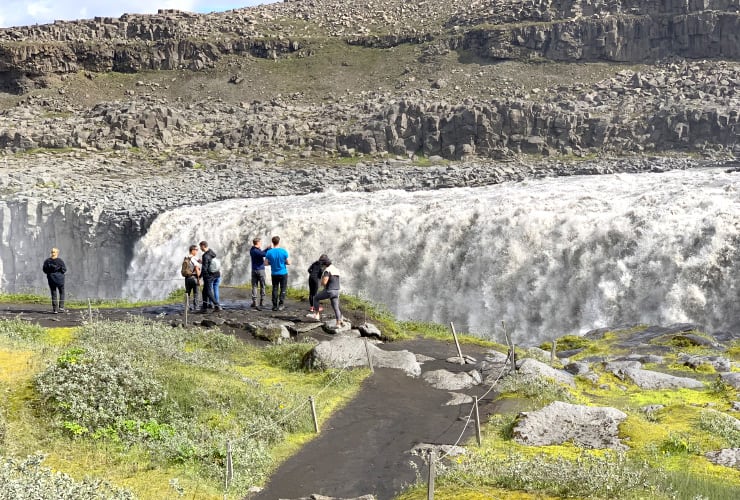

Another name often given to Dettifoss is “The Collapsing Waterfall”. The falls are so immense that the falling water appears to disappear into a void of mist and thundering sound. To access Dettifoss there is a large parking area, complete with excellent facilities, and a lava gravel path that winds its way through rock basalt fields, debris from ancient earthquakes and floods. If you’re blessed enough to experience a sunny day you’ll be greeted by a large rainbow rising up through the mist from the canyon floor. Dettifoss cannot be described as beautiful but it is certainly overwhelming.
Goðafoss
Pronounced: go • da • foss
In contrast to Dettifoss, Goðafoss is commonly referred to as “The Beauty” and “Waterfall of the Gods”. The name comes from both its indescribable beauty and also the place where Viking leader Þorgeir Ljósvetningagoði threw statues of the Old Gods into the water symbolizing the country’s official conversion to Christianity in 1000 AD. As with so many of the most viewable waterfalls in Iceland, Goðafoss is easily accessible from the Ring Road and has several different platforms to choose from (on either side of the Skjálfandafljót River) each with a unique perspective.
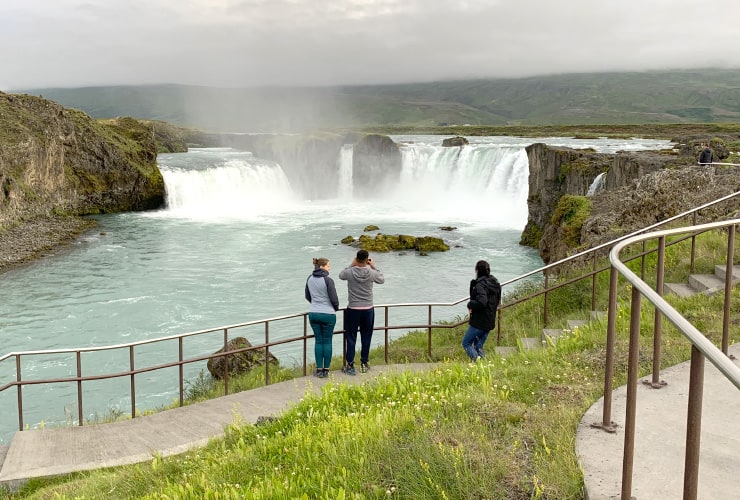
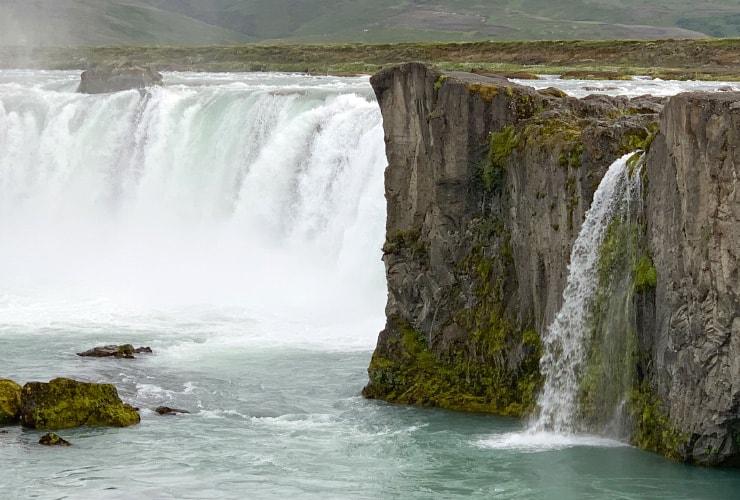
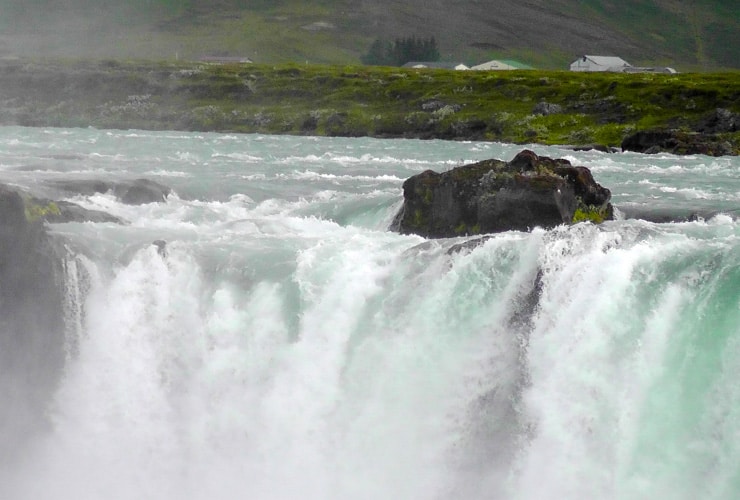
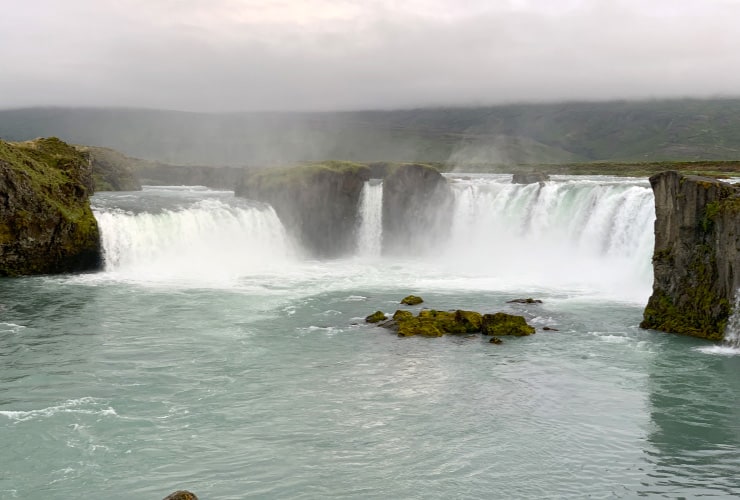
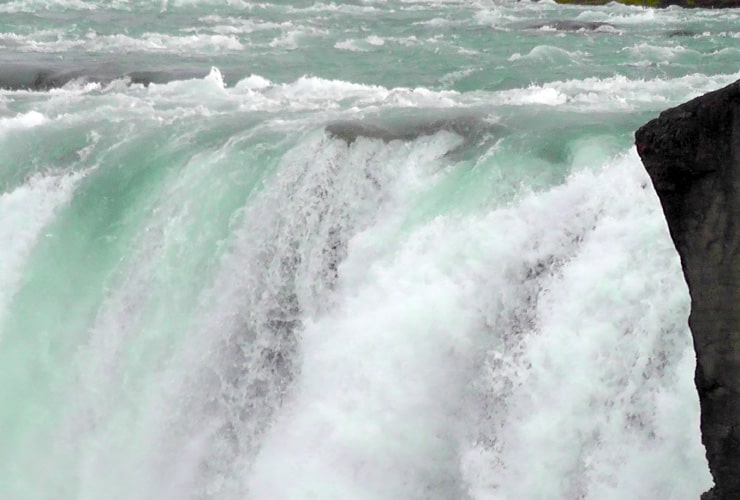
Goðafoss has three distinct areas of overflow, a narrow flow in the center surrounded by two wider falls converging in the river below. In total Goðafoss measures 39.4’ (12 m) high and 98.4’ (30 m) in width while taking on a bowl shape. There’s even a quaint little falls emerging out of a gap in the east rock face. Because it is fed by the Vatnajokull glacier, the water flow remains pretty constant all year round. As a bonus . . . if you follow the bright blue river downstream there is a magnificent falls, Geitafoss, just before you cross over the bridge.
Mígandifoss
Pronounced: meo • lan • dee • foss
For a change of pace . . . we present Mígandifoss, a magnificent ocean waterfall that, while technically visible from the Ring Road, really needs to be seen from waters within the Eyjafjörður fjord. We were lucky enough to have this included in our whale watching tour so we were rewarded with a perfect view.
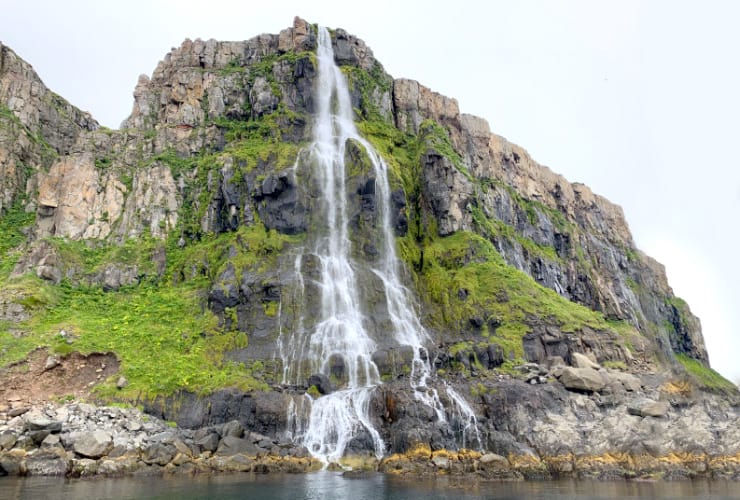
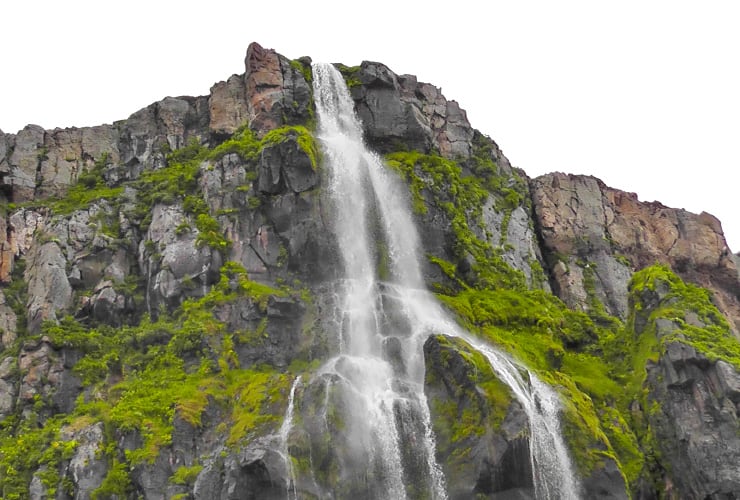
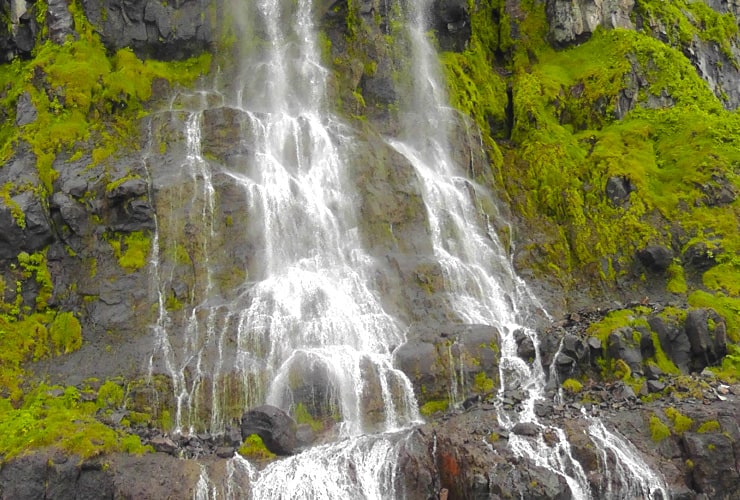
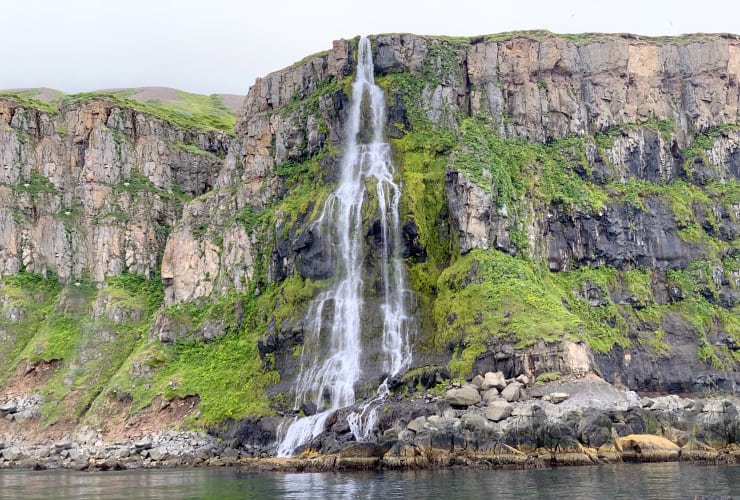
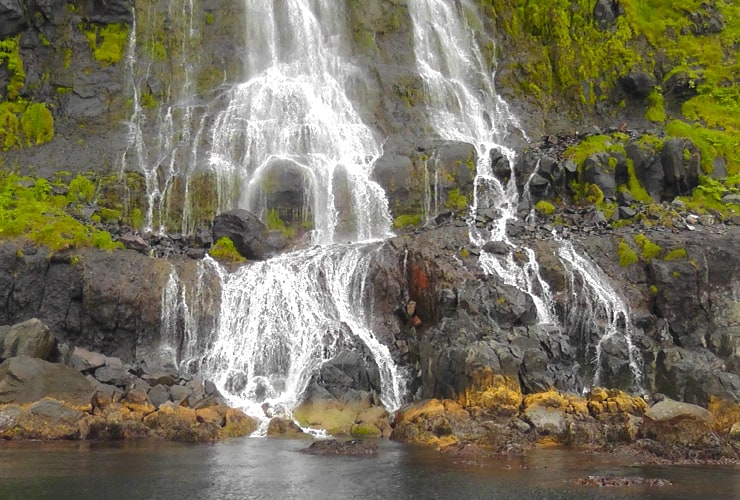
The falls start majestically atop a mountain peak and work their way down through a wonderfully intricate number of alternative paths. Mígandifoss measures an impressive 230’ (70 m) in height but its the variety of ribbon-like water avenues plunging down the moss-rich mountainside that makes it one of the most viewable waterfalls in Iceland.
Barnafoss
Pronounced: bard • na • foss
As you wind your way around the Ring Road in western Iceland you are rewarded with a geological wonder that has produced a powerful cascade and a stunningly beautiful set of lava waterfalls. First there is the powerful Barnafoss or “Children’s Fall” so called after a local legend of two missing girls whose footsteps were last seen at the edge of the falls. Barnafoss is really more a continuous flow of powerful rapids or cascades on the Hvítá River. The strength of the flow is caused by the wide river being diverted into a narrow rocky chute with several switchback-like curves. There are several trails, and even a bridge, that have fantastic lookout points for viewing Barnafoss.
Hraunfossar
Pronounced: freem • foss • sas
As you move downstream westward along the Hvítá, the river calms until a series of small rapids. At this point a unique geological occurrence creates a long series of spider-like falls that stretches some 2,950’ (900 m) along the north shore. In appearance, much like the Plitvice Lakes of Croatia, Hraunfossar produces numerous mini-springs that emerge from under the edge of Hallmundarhraun, a massive pillow lava field. The lush vegetation and moss that surrounds the rock surface provides a beautiful contrast against the dark lava, white cascades and clear blue water of the river.
As you know, we love our North Carolina waterfalls. That will never change but the most viewable waterfalls in Iceland make the Tar Heel state’s falls pale in comparison. It isn’t any one thing, though sheer size certainly makes a difference. It’s more how the water, along with the glaciers, volcanic and geothermal activity have shaped such a unique visual experience unseen anywhere else in the world.
Have you had a chance to visit Iceland yet? If not please feel free to ask us any questions . . . we’ll be happy to pass along our experience and advice on how to best enjoy this amazing island country.